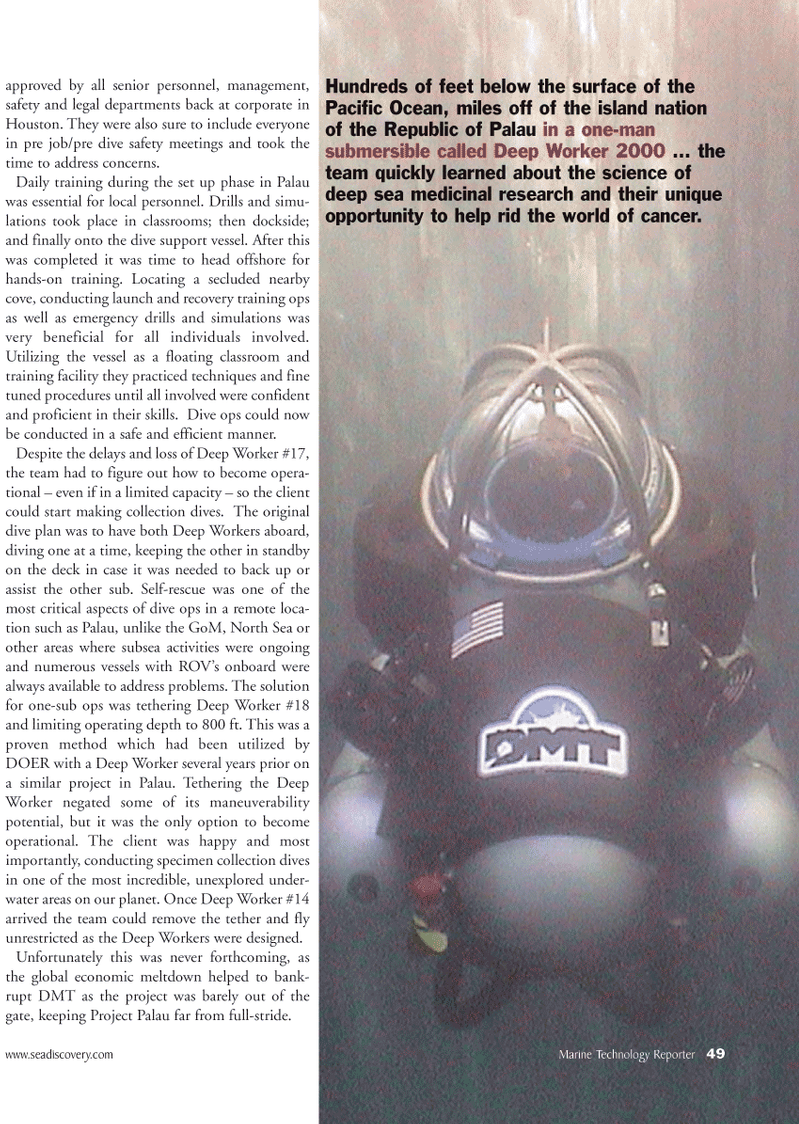
Page 49: of Marine Technology Magazine (April 2011)
Oil & Gas SubSea Monitoring
Read this page in Pdf, Flash or Html5 edition of April 2011 Marine Technology Magazine
www.seadiscovery.com Marine Technology Reporter 49 approved by all senior personnel, management, safety and legal departments back at corporate in
Houston. They were also sure to include everyone in pre job/pre dive safety meetings and took the time to address concerns.
Daily training during the set up phase in Palau was essential for local personnel. Drills and simu- lations took place in classrooms; then dockside; and finally onto the dive support vessel. After this was completed it was time to head offshore for hands-on training. Locating a secluded nearby cove, conducting launch and recovery training ops as well as emergency drills and simulations was very beneficial for all individuals involved.
Utilizing the vessel as a floating classroom and training facility they practiced techniques and fine tuned procedures until all involved were confident and proficient in their skills. Dive ops could now be conducted in a safe and efficient manner.
Despite the delays and loss of Deep Worker #17, the team had to figure out how to become opera- tional – even if in a limited capacity – so the client could start making collection dives. The original dive plan was to have both Deep Workers aboard, diving one at a time, keeping the other in standby on the deck in case it was needed to back up or assist the other sub. Self-rescue was one of the most critical aspects of dive ops in a remote loca- tion such as Palau, unlike the GoM, North Sea or other areas where subsea activities were ongoing and numerous vessels with ROV’s onboard were always available to address problems. The solution for one-sub ops was tethering Deep Worker #18 and limiting operating depth to 800 ft. This was a proven method which had been utilized by
DOER with a Deep Worker several years prior on a similar project in Palau. Tethering the Deep
Worker negated some of its maneuverability potential, but it was the only option to become operational. The client was happy and most importantly, conducting specimen collection dives in one of the most incredible, unexplored under- water areas on our planet. Once Deep Worker #14 arrived the team could remove the tether and fly unrestricted as the Deep Workers were designed.
Unfortunately this was never forthcoming, as the global economic meltdown helped to bank- rupt DMT as the project was barely out of the gate, keeping Project Palau far from full-stride.
Hundreds of feet below the surface of the
Pacific Ocean, miles off of the island nation of the Republic of Palau in a one-man submersible called Deep Worker 2000 ... the team quickly learned about the science of deep sea medicinal research and their unique opportunity to help rid the world of cancer.

 48
48

 50
50
